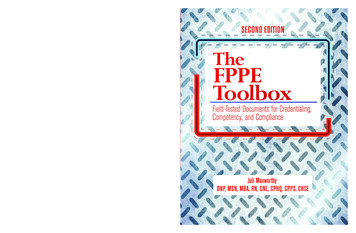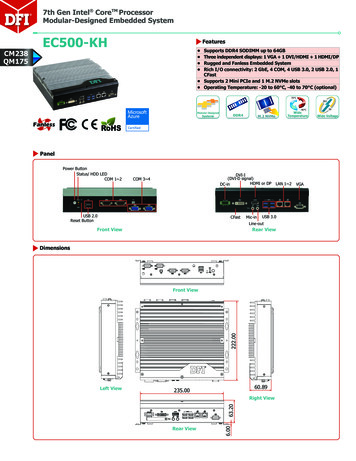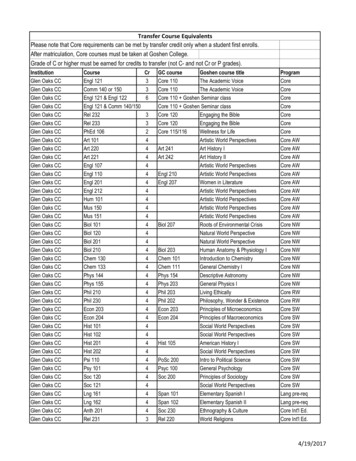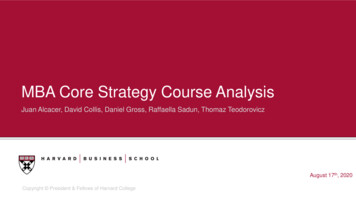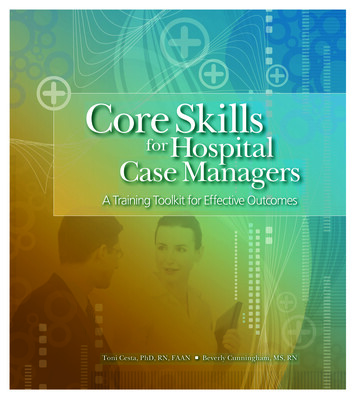
Transcription
CoreSkillsforHospitalCase ManagersA Training Toolkit for Effective OutcomesToni Cesta, PhD, RN, FAANBeverly Cunningham, MS, RN
Core SkillsHospitalCase ManagersforA Training Toolkit for Effective OutcomesToni Cesta, PhD, RN, FAANBeverly Cunningham, MS, RN
Core Skills for Hospital Case Managers: A Training Toolkit for Effective Outcomes is published by HCPro, Inc.Copyright 2009 HCPro, Inc.All rights reserved. Printed in the United States of America.5 4 3 2 1ISBN: 978-1-60146-353-1No part of this publication may be reproduced, in any form or by any means, without prior written consent ofHCPro, Inc., or the Copyright Clearance Center (978/750-8400). Please notify us immediately if you have receivedan unauthorized copy.HCPro, Inc., provides information resources for the healthcare industry.HCPro, Inc., is not affiliated in any way with The Joint Commission, which owns the JCAHO and Joint Commission trademarks. MAGNET , MAGNET RECOGNITION PROGRAM , and ANCC MAGNET RECOGNITION aretrademarks of the American Nurses Credentialing Center (ANCC). The products and services of HCPro, Inc., andThe Greeley Company are neither sponsored nor endorsed by the ANCC. The acronym MRP is not a trademark ofHCPro or its parent corporation.Toni Cesta, PhD, RN, FAAN, AuthorGenevieve d’Entremont, CopyeditorBeverly Cunningham, MS, RN, AuthorAdam Carroll, ProofreaderRebecca Hendren, Senior Managing EditorSusan Darbyshire, Art DirectorJamie Gisonde, Executive EditorMatt Sharpe, Production SupervisorEmily Sheahan, Group PublisherClaire Cloutier, Production ManagerBrenda Rossi, Cover DesignerJean St. Pierre, Director of OperationsMike Mirabello, Senior Graphic ArtistAdvice given is general. Readers should consult professional counsel for specific legal, ethical, or clinical questions. Arrangements can be made for quantity discounts. For more information, contact:HCPro, Inc.P.O. Box 1168Marblehead, MA 01945Telephone: 800/650-6787 or 781/639-1872Fax: 781/639-2982E-mail: customerservice@hcpro.comVisit HCPro at its World Wide Web sites:www.hcpro.com and www.hcmarketplace.com06/200921674
ContentsList of Figures.xiAbout the Authors.xviiAccessing the Tools and Templates on the CD-ROM.xixChapter 1: Hospital Case Management 101: The Basics.1What Is Case Management?. 1Initial Drivers for Hospital Case Management. 2The integrated (dyad) model. 4The collaborative (triad) model. 5How are these models alike?. 7Goals in Various Settings. 8Definition of case management. 9Who is the case manager?. 9Case management: The new generation. 9Chapter 2: Case Manager Role.13Skills of the Effective Case Manager. 13Supporting the Case Manager. 14Orientation. 15Preceptorship. 16Keeping Case Management Staff Informed. 16Key Roles and Functions for Hospital Case Managers. 17Role 1: Patient flow—coordination/facilitation of care. 17Role 2: Utilization and resource management. 18Role 3: Denial management. 19 2009 HCPro, Inc.Core Skills for Hospital Case Managers
ivContentsRole 4: Variance tracking. 20Role 5: Transitional and discharge planning. 22Role 6: Quality management. 24Role 7: Psychosocial assessment and counseling. 27Role 8: Regulatory requirements. 28Access Point Case Management. 28Admitting Department Case Management. 28Coping with Medical Necessity on Admission. 30Emergency Department Case Management. 31Role 1: Gatekeeping. 31Role 2: Initiation and facilitation of care. 31Role 3: Intake and utilization processes. 32Role 4: Encouraging the use of reimbursable diagnoses. 32Other roles. 32How to find patients. 33Variance management in the emergency department. 33Integrating case management and social work: Shared responsibilities. 34Measuring the success of the emergency department case manager. 35Other Optional Functions: Clinical Documentation Improvement. 36Role of the Social Worker. 37Role of the Discharge Planning Specialist. 39Role of the Physician Advisor. 40Chapter 3: Roles, Functions, and Caseloads.45Scope of Position. 45Payer mix. 48Intensity of service. 48Complexity of patients. 48Length of stay. 48Determining Staffing Ratios in the Integrated Model. 49Core Skills for Hospital Case Managers 2009 HCPro, Inc.
ContentsDetermining Staffing Ratios in the Collaborative Model. 49Determining the Number of Positions Needed for the Department. 50Number of positions needed for integrated model. 51How many social workers do I need?. 51Staffing for the emergency department in both models. 52Social worker staffing in the emergency department. 53Vacation/holiday/sick coverage. 54Chapter 4: The Case Management Process.57Steps. 57Step 1: Selection and screening. 57Step 2: Patient assessment and diagnosis. 58Step 3: The case management plan. 62Step 4: Linking the patient to needed services. 62Step 5: Implementation and coordination. 63Step 6: Monitoring of care processes. 63Step 7: Advocacy. 63Step 8: Evaluation and follow-up. 63Medical Record Documentation. 63Where do I obtain the information for documentation?. 65Ongoing documentation. 66Keeping Track of Your Information. 68Chapter 5: The Case Manager’s Role in Transitionaland Discharge Planning.71Case Management’s Responsibility. 71Operationalizing Discharge Planning. 73Influences on the discharge plan: Patient. 73Influences on the discharge plan: Family. 75Influences on the discharge plan: Payer. 76Influences on the discharge plan: Physician. 77 2009 HCPro, Inc.Core Skills for Hospital Case Managersv
viContentsInfluences on the discharge plan: Processes. 80Influences on the discharge plan: Departmental staffing model. 81Influences on the discharge plan: Case manager/social worker relationships. 81Influences on the discharge plan: Case manager and social worker skill sets. 84Influences on the discharge plan: Manager/director. 84Influences on the discharge plan: Communicating with patients and families. 84Influences on the discharge plan: Communicating with the interdisciplinary care team. 84Influences on the discharge plan: Patient safety events. 85Process of Discharge Planning. 85Discharge planning triage process. 85Internal solutions to discharge planning issues. 89External solutions to discharge planning issues. 91Hospital Discharge Planning: Helping Family Caregivers Through the Process. 92Process Changes to Improve Discharge Planning. 93Factors related to placement decisions. 95The Joint Commission and Discharge Planning. 96Measuring the Success of Discharge Planning. 97Chapter 6: Utilization Management.101Hospital Reimbursement. 102Payers. 103Reimbursement methods. 103Role of criteria. 104Role of the case manager. 104Stages of UM Coordination. 106Stage 1: Assessment of severity of illness and intensity of service at admission. 106Stage 2: Assessment of medical necessity for continued stay. 110Stage 3: Communication with the payer. 110Stage 4: Discharge planning. 116Core Skills for Hospital Case Managers 2009 HCPro, Inc.
ContentsThe UM Process. 116Physician advisor and the UM role. 118UM and the revenue cycle. 120Time frames for utilization review. 121Regulations regarding UM. 122Managing UM for Medicare patients. 123The Role of the Payers’ Contract with UM. 128UM outcome measures. 128Chapter 7: Managing Long Length of Stay Patients.131Definition of Long Length of Stay. 131Strategies for Ongoing Management of Long LOS Patients. 132Strategy 1: Identify long LOS patients and related issues. 133Strategy 2: Review LOS issues during interdisciplinary care rounds. 133Strategy 3: Conduct weekly long LOS rounds. 133Strategy 4: Determine which patients are acute and which are not. 135Using Data to Identify and Understand Long LOS Patients. 137Chapter 8: Denials: Prevention and Appeals Strategies.141What Causes Denials?. 143Payers’ contribution to denied claims. 148Case Management’s Role in Denials. 150Front-end processes. 150Concurrent processes. 153Back-end processes. 155Understanding Denials Associated with a Case Manager’s Population. 159Chapter 9: Reimbursement.163Historical Precedence of Paying for Healthcare. 163Payment Structure. 165Denial Process. 167 2009 HCPro, Inc.Core Skills for Hospital Case Managersvii
viiiContentsOngoing Reimbursement Challenges: Recovery Audit Contractors. 173Case managers’ role with RACs. 174Ongoing Reimbursement Challenges: Present on Admission. 177Chapter 10: The Role of the Case Manager in Patient Flow.183A History of Patient Flow. 183Queuing theory. 185Demand and Capacity Management. 186Developing an Understanding of Patient Flow. 187Access. 187Throughput. 190Discharge. 194Using Variances to Identify and Correct Patient Flow Issues. 195Reporting variance data. 198Using the data. 203The patient flow scorecard. 207Chapter 11: Measuring Success: Strategic Outcome Measures.209Measuring Outcomes. 209Process metrics and outcome metrics. 210What are your department’s goals?. 211Case Management Outcome Levels. 211Organizational outcomes. 212Length of stay. 212Third-party payer denials. 213Observation hours. 214Quality Outcome Metrics. 214Readmissions. 215Discharge and disposition delays. 215Patient satisfaction. 216Inappropriate admissions. 216Core Skills for Hospital Case Managers 2009 HCPro, Inc.
ContentsService outcomes. 216Productivity Measures. 216Other Metrics to Consider. 218Comparing Your Outcomes Against National Benchmarks. 219Benchmarking for length of stay. 219Case-mix index. 220Case management clinical benchmarks. 220Case management service benchmarks. 221Case management productivity benchmarks. 221Tracking cost avoidance. 221Identifying Key Case Management Performance Metrics. 222The Case Management Department Report Card. 223Chapter 12: Dealing with the Uninsured and Underinsured.227Identification of the Unfunded Patient. 228Risks for unfunded patients. 228Undocumented aliens. 232Underfunded Patients. 232The unfunded multidisciplinary team. 235ED Case Management and Unfunded Patients. 236Discharge Strategies for the Uninsured. 238Medical necessity and the unfunded patient. 241Outcomes for Unfunded Patients. 241Chapter 13: Working with Multidisciplinary Teams. 247Case study of a multidisciplinary team. 256Chapter 14: Crucial Communication and Conflict Resolution.261Hospital Clinical Departments. 264Patient access. 264Physicians. 264 2009 HCPro, Inc.Core Skills for Hospital Case Managersix
xContentsHealth information management. 265Peer case managers (internal). 265Internal social workers. 267External case managers and social workers. 267Next level of care providers. 268Payers. 268Denial and appeal staff. 269CFO. 269Billing. 270Nursing. 270Patients. 270Families. 271Case management administration. 271Guest relations. 271Conflict. 271Communication in a High-Tech World. 274Electronic medical record. 274Electronic UM record. 274Automated communication through handheld devices. 275Automated medical necessity criteria. 275Electronic discharge planning. 275Electronic telephone messaging to physicians. 275Continuing Education Instructional Guide.279Continuing Education Exam. 284Continuing Education Evaluation. 293Core Skills for Hospital Case Managers 2009 HCPro, Inc.
List of FiguresChapter 1Figure 1.1: Traditional case management model. 3Figure 1.2: Partially integrated case management model. 3Figure 1.3: Partially integrated case management model, version 2.
Case Managers Core Skills forHospital A Training Toolkit for Effective Outcomes Toni Cesta, PhD, RN, FAAN Beverly Cunningham, MS, RN
